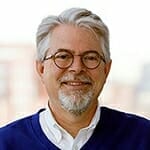
Also Contributing Editors:
Rusty Brunner, Human Resources Manager, Colorado School of Mines Foundation
Succession planning and robust professional development programs are not often associated with advancement shops in higher education. Some feel that with the high employee turnover rate in advancement, they cannot justify the financial investment. However, an alternative perspective is that professional development leads to increased employee performance and retention, making it a sound investment.
At the Colorado School of Mines Foundation (CSMF), leadership values staff development and has implemented a scaffolded skills-based development plan. Supporting employees and creating long-term succession planning has been integrated into their culture. This fundamental belief in how leadership views employment has played a big part in creating a higher-than-average retention rate.
During an interview with Rusty Brunner, Human Resources Manager and Steve Kreidler, Vice President of Administration/CFO from the Colorado School of Mines Foundation (CSMF), I learned about their vision and approach.
A growth focused and skills-based model
The professional development and succession plan, in its current form, began two years ago at the CSMF. It is more than a commitment to provide employees with an annual webcast or two; it is a fundamentally different way of approaching employment. It is a growth focused, integrated plan that is intentionally built into the culture and performance metrics. Employees benefit from a mix of required and voluntary growth programming.
All employees are given performance goals which include the accumulation of soft and technical skills. After participating in trainings, employees share their new insights with co-workers. This structured skills-based approach sets employees up to make positive career progress. Employees gain skills that are relevant to both their current role as well as aspirational ones. Even before positions become vacant the Foundation has a pipeline of competent and job-ready employees and been intentional about succession planning. There is always someone who is qualified to step in and take over.
Brunner and Kreidler described it as a ladder where each skill is a rung. As employees master basic skills, new skill training is introduced that builds upon that prior learning. Over time employees move up their personalized ladder to achieve incremental and intentional progress in their career advancement.
The ultimate goal is a fully realized succession plan for each leadership and management role. As positions become available, well-qualified internal candidates are prepared to step-in and hit the ground running without the need for the long acclimation periods that external candidates often require. This system sets up internal employees to be one of the best options when vacancies occur. The CSMF does seek national candidates for most positions and is ensuring that at least one outstanding candidate will be in the applicant pool from inside the organization.
Why it’s unique
Two of the most common arguments against providing advancement and administrative professionals with significant professional development opportunities are productivity and retention concerns. It is too often believed that participating in professional development activities takes time away from immediate, day-to-day job activities thus reducing productivity. Also, many leaders have feared that employees with additional skills will leave to work at other institutions. The CSMF doesn’t think that these concerns are reflective of the culture that they have cultivated and grown over the past two years.
It could be argued that an employee attending a webcast or multi-day conference, isn’t working towards the established strategic plan. Some leaders feel that this time would be better spent making progress on goals, crossing to-do’s off of the list. But Brunner and Kreidler believe the skills that are gained at these webcasts and conferences enable employees to perform at a higher level, more than compensating for the few hours dedicated to training.
When I asked Brunner and Kreidler if they were concerned that employees who are highly skilled, at the Foundation’s expense, will accept opportunities elsewhere, they empathetically said “no.” In fact, they feel that the exact opposite is true. Employees who are supported, who are provided with well-structured and consistent opportunities to succeed and grow, are more likely to remain at the institution long-term. Multiple surveys show that employees regard professional development as one of their institution’s most important job benefits. Their theory is supported by a lower-than-average turnover rate of just 6%.
Employees at the CSMF are set up for a career of consistent and robust training and support. This has contributed to a workplace culture where employees are choosing to stay at higher rates. They are also seeing gains in employee performance.
How they did it
Changing the culture of an entire foundation is no easy task. These deep-rooted changes take time, planning, and commitment. Culture change doesn’t happen overnight, and in this case, it certainly didn’t happen unintentionally. After Kreidler joined the CSMF, he knew that he wanted to infuse the culture with commitments to professional development and a forward-thinking growth mindset. With this goal in mind, he set to work.
The first step was aligning individual employee professional development goals with the Big 3 strategic goals of the Foundation; generate private support and engagement for the Colorado School of Mines, manage, invest, and utilize donor-provided funds with integrity, transparency, and prudence, and create a culture of excellence. Without this alignment, the program would fail to thrive. A Core Values committee established these four values:
- Mutual support
- Respect
- Integrity
- Service
To achieve alignment, these goals and values are used in general communications as well as employee goal setting and performance reviews.
CSMF also invests in a membership with Academic Impressions that provides access to a robust online library of resources and hundreds of live and interactive training opportunities that support the various needs of employees at all levels. This provides employees with a convenient and high-quality way to gain the skills needed to climb the rungs in their personal career progression ladder. In the first full year of this membership, the 50+ employees engaged over 200 Academic Impressions modules across a wide array of formats.
Additional professional development formats CSMF provides include:
- Monthly lunch and learn series, which incorporates all required and some voluntary training
- Technical skill trainings through providers such as QuickHelp’s BrainStorm training tool and other software specific vendors
- Senior leadership-led management and leadership content
- Leadership and Executive coaching for several high potential employees each year
- Ample funding for professional organizations and their seminars and annual meetings within the various disciplines across CSMF
- Seminar style trainings provided by content experts
- Professional coaching opportunities for those seeking career advancement
This combination of expectation and opportunity has worked. Professional development is so ingrained in their culture that employees actively seek out the opportunities with which they are provided instead of waiting for opportunities to come to them. Managers are building employee-specific packages to increase productivity and workplace success.
Continued iteration and investment
This scaffolded professional development and succession planning process has already been effective. But Kreidler and Brunner have plans to make future improvements. They see this as the 1.0 version of the program; versions 2.0 and 3.0 are just around the corner. Part of the big picture will be the launch of an “alumni employee” continuing communication program.
Despite CSMF’s best efforts to retain employees, it is inevitable that some will choose to transition to outside roles. This could be due to promotions they can achieve outside the organization or other life-altering circumstances such as a geographical change in a partner’s career. But Kreidler and Brunner feel that these former employees still have a lot of value to offer the Foundation. This could be in the form of high-quality referrals, information, or perhaps they could even be a boomerang employee and return several years down the road. Whatever the circumstances may be, they see value in continuing to cultivate these relationships. A great way to do this is by treating them similar to school alumni.
Alumni receive communications that update them on school happenings, new strategic initiatives, and maintain affinity. Past employees will receive similar communications relevant to them. This program will launch during FY22. CSMF employees will receive career-long support and a connection that is unique among most employers.
Implementing a skills-based professional development model
While the benefits of implementing a scalable, growth-focused professional development model at your institution are many, it might also seem like the challenges to getting started are equally abundant. Using the Colorado School of Mines Foundation’s approach as a guide, below are steps to consider when getting started.
In thinking about the model:
- Create alignment between individual professional development and the Foundation’s strategic direction
- Focus on both job-specific and leadership skills
- Consider a phased rollout approach over a predetermined time frame
- In terms of professional development content and learning paths, consider supplementing the existing internal efforts with outside expertise to create a combined network of internal facilitators and outside experts. This will help ensure breadth and depth of content
- Determine if you will use a learning management system
- Ensure post-training reinforcement via managers, official report-outs to peers, communications, course repetition, etc.
In thinking about the content:
- Determine how to make it relevant and measurable
- Scaffold training to be timely and ensure the content remains accessible over time
- Create training to be multi-modal, serving a diversity of learning styles, and focused on practical outcomes
- Make training applicable to real-world situations
All of these considerations vary depending on your Foundation’s resources and culture. Regardless, what remains of upmost importance are the core values upon which the professional development model is built and the narrative by which it is conveyed. For the Colorado School of Mines Foundation, the core belief that has guided this initiative is that performance management should be amplified by employee development, which will ensure a work environment where modern employees don’t feel stuck in a repetitive rut, rather they envision and push the boundaries of their greatest potential. The return on this investment will manifest for years to come, both for the individual employee and the foundation.


